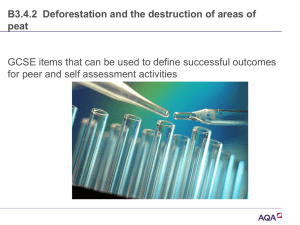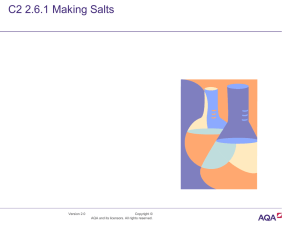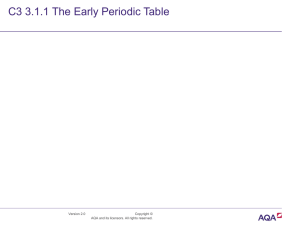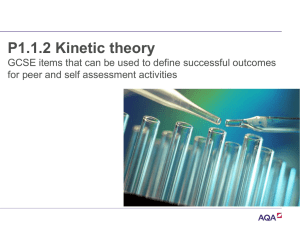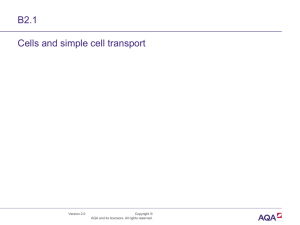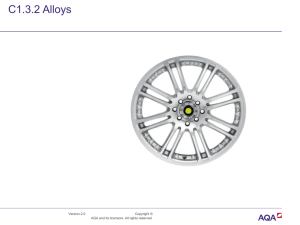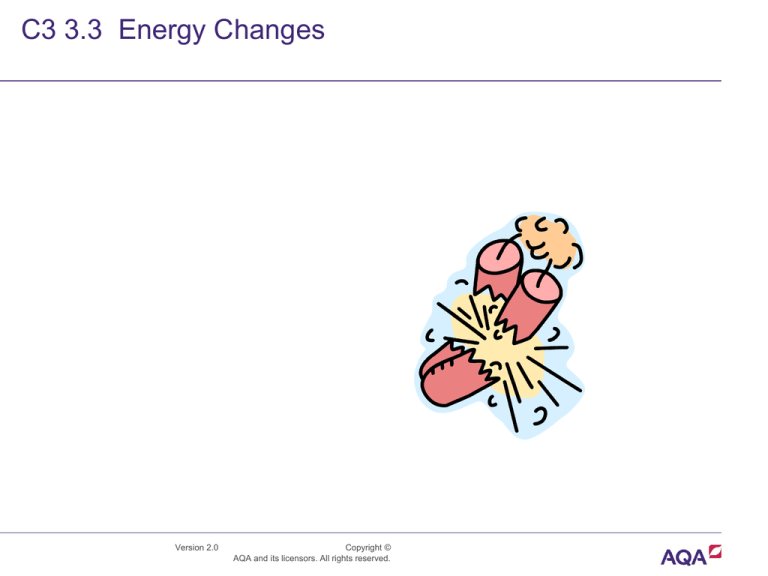
C3 3.3 Energy Changes
Version 2.0
Copyright ©
AQA and its licensors. All rights reserved.
Using Exam pro items to support successful
outcomes
•
C3 3.3
• Learners will be able to test their progress against learning
outcomes using questions from past AQA GCSE examinations
Version 2.0
Copyright © AQA and its
licensors. All rights reserved.
Foundation Tier Q09W 3F 06
.
Read the information about energy changes and then answer the questions.
A student did an experiment to find the energy change when hydrochloric acid reacts with sodium
hydroxide. The equation which represents the reaction is:
HCl + NaOH → NaCl + H2O
The student used the apparatus shown in the diagram.
The student placed 50 cm3 of hydrochloric acid in a glass beaker and measured the temperature.
The student then quickly added 50 cm3 of sodium hydroxide solution and stirred the mixture with the
thermometer. The highest temperature was recorded.
The student repeated the experiment, and calculated the temperature change each time.
Version 2.0
Copyright © AQA and its
licensors. All rights reserved.
•
C3 3.3
•
(a)
The biggest error in this experiment is heat loss.
Suggest how the apparatus could be modified to reduce heat loss.
.....................................................................................................................................
.....................................................................................................................................
(1)
(b)
Suggest why it is important to stir the chemicals thoroughly.
.....................................................................................................................................
(1)
(c)
Which one of these experiments was probably carried out on a different day to the
others?
Explain your answer.
.....................................................................................................................................
.....................................................................................................................................
(1)
(d)
Suggest why experiment 4 should not be used to calculate the average temperature
change.
.....................................................................................................................................
.....................................................................................................................................
(1)
Version 2.0
Copyright © AQA and its
licensors. All rights reserved.
C3 3.3
•
(e)
Calculate the average temperature change from the first three experiments.
.....................................................................................................................................
Answer = .............................. °C
(1)
(f)
Use the following equation to calculate the energy change for this reaction.
energy change in joules = 100 × 4.2 × average temperature change
.....................................................................................................................................
Answer = .............................. J
(1)
(g)
Which one of these energy level diagrams, A or B, represents the energy change
for this reaction?
Explain why.
.....................................................................................................................................
.....................................................................................................................................
(1)
(Total 7 marks)
Version 2.0
Copyright © AQA and its
licensors. All rights reserved.
C3 3.3
Mark scheme- Foundation
Answer
Extra Information
Mar
k
eg plastic (beaker) / insulation / lid / cover or
any mention of enclosed
any sensible modification to reduce heat loss
ignore prevent draughts
ignore references to gas loss
1
(b)
all the substances react or all (the
substances) react
fully / completely or heat evolved quickly or
distribute heat
accept to mix them
‘so they react’ is insufficient for the mark
accept increase chances of (successful) collisions / collision
rate increase
do not accept rate of reaction increase / make reaction faster
1
(c)
experiment 2 and different / higher / initial /
starting temperature
accept experiment 2 and the room is hotter / at higher
temperature
do not accept temperature change / results higher
1
(d)
temperature change does not fit pattern
accept anomalous / odd or it is the lowest or it is lower than the
others or it is different to the others
‘results are different’ is insufficient
1
(e)
7 / 7.0
(f)
100 × 4.2 × 7) = 2940
ecf from (e)
1
(g)
diagram A and reaction exothermic / heat
evolved / Δ H is negative /
temperature rises
accept energy is lost (to the surroundings)
1
Total
7
Q1
(a)
1
Version 2.0
Copyright © AQA and its
licensors. All rights reserved.
Higher Tier – Q09S 3H 05
•
An airship caught fire when it was coming in to land in 1937. The airship was filled with
hydrogen. A spark or flame ignited the hydrogen. The hydrogen reacted with oxygen in
the air to produce water.
(a)
The equation for the reaction can be represented using structural formulae for the
chemicals.
2H–H+O=O→2H–O–H
Use the bond energies given in the table to help you to calculate the energy change
for this reaction.
Bond
Bond energy in kJ per mole
H–H
436
O=O
498
O–H
464
Energy change = ................................... kJ
(3)
Version 2.0
Copyright © AQA and its
licensors. All rights reserved.
C3 3.3
•
(b)
C3 3.3
Explain, in terms of making and breaking bonds, why this reaction is exothermic.
.....................................................................................................................................
.....................................................................................................................................
(1)
(c)
Use the energy level diagram for this reaction to help you to answer these
questions.
Version 2.0
Copyright © AQA and its
licensors. All rights reserved.
•
(i)
The hydrogen did not burn until ignited by a spark or flame.
Explain why.
...........................................................................................................................
...........................................................................................................................
(1)
(ii)
Platinum, a transition metal, causes hydrogen to ignite without using a spark
or flame.
Explain why.
...........................................................................................................................
...........................................................................................................................
...........................................................................................................................
...........................................................................................................................
(2)
(Total 7 marks)
Version 2.0
Copyright © AQA and its
licensors. All rights reserved.
C3 3.3
Mark scheme- Higher
•
C3 3.3
Q1
Answer
Extra Information
Mar
k
(a)
(bonds broken) = 1370 (kJ)
(bonds made) = 1856 (kJ)
change in energy = (–) 486
ecf
ignore sign
correct answer with or without working = 3
marks
ecf
ignore sign
correct answer with or without working = 3 marks
1
1
1
(b)
energy released from forming new bonds is
greater than the energy
needed to break existing bonds
allow the energy needed to break bonds is less than the
energy released in forming bonds
do not accept energy needed to form bonds
1
(c) (i)
energy barrier needs to be overcome
or
activation energy supplied / needed
allow energy needed to start reaction or energy needed to
break bonds
accept high activation energy
1
(c) (ii)
lowers activation energy(*)
or
provides lower energy pathway / route(*)
(*)2 mark answers
allow provides alternative pathway or platinum / it is a
catalyst for 1 mark
2
Total
7
Version 2.0
Copyright © AQA and its
licensors. All rights reserved.
Q2 Higher Tier QCJ 98 H2 14
•
Some of the hydrogen and chlorine are reacted together to form hydrogen chloride.
H2(g) + Cl2(g) → 2HCl(g)
(i)
Bond
Bond energy in kJ/mol
Cl–Cl
242
H–Cl
431
H–H
436
Use the bond energies to calculate the energy change for the formation of hydrogen
chloride.
.....................................................................................................................................
.....................................................................................................................................
.....................................................................................................................................
.....................................................................................................................................
Energy change = .................................. kJ/mol
(3)
Version 2.0
Copyright © AQA and its
licensors. All rights reserved.
C3 3.3
•
(ii)
C3 3.3
Is this reaction exothermic or endothermic? Explain your answer.
.....................................................................................................................................
.....................................................................................................................................
.....................................................................................................................................
(2)
(iii)
Explain why hydrogen chloride only acts as an acid when dissolved in water.
.....................................................................................................................................
.....................................................................................................................................
.....................................................................................................................................
(3)
(Total 8 marks)
Version 2.0
Copyright © AQA and its
licensors. All rights reserved.
Mark scheme- Higher
Q2
(i)
Answer
436 + 242 = 678 (kJ)
2 × 431 = 862(kJ)
answer = 184
(ii)
Exothermic
more energy released by, bond formation than
needed for bond breaking
(iii)
hydrogen chloride is (a) covalent (compound)
when added to water it forms ions or H+ (and
Cl-)
hydrogen ions or H+ causes a solution to be
acidic
•
Extra Information
Mark
first two marks can be awarded if
answer is incorrect
ignore sign
1
1
1
both parts to be marked
depending on answers given in
(i)
1
1
1
1
`
Total
Version 2.0
Copyright © AQA and its
licensors. All rights reserved.
C3 3.3
8
•
C3 3.3

